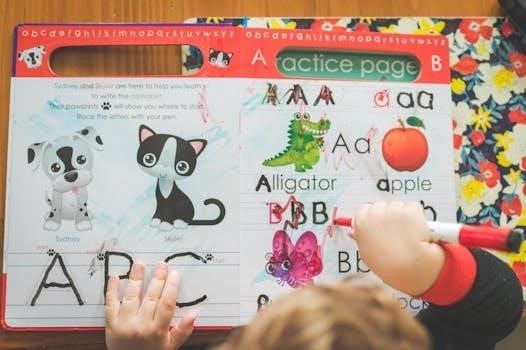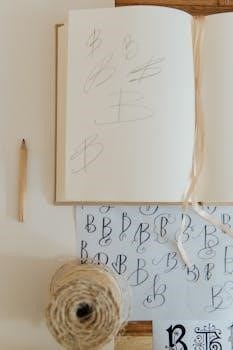What are Large Letter Tracing Worksheets PDF?
Large letter tracing worksheets in PDF format are educational resources designed to assist young children in learning how to form letters correctly. These worksheets typically feature sizable letter outlines, directional arrows, and starting points. The main goal is to improve handwriting skills through repetitive practice.
Definition and Purpose
Large letter tracing worksheets in PDF format are specifically designed educational tools aimed at helping young children develop essential handwriting skills. These worksheets feature enlarged, clear letter formats to facilitate easy tracing, typically including directional arrows and starting points to guide proper letter formation. The primary purpose is to provide a fun and engaging way for kids to learn the alphabet, improve fine motor skills, and build a solid foundation for future writing proficiency.
Benefits of Using Large Letter Tracing Worksheets
Utilizing large letter tracing worksheets offers numerous benefits for young learners; These worksheets significantly improve letter recognition and formation by providing a clear, easy-to-follow format. They enhance fine motor skills and hand-eye coordination, crucial for handwriting development. Additionally, these worksheets boost confidence in writing, making learning more enjoyable and less daunting. They also serve as an excellent tool for reinforcing early literacy skills and preparing children for more advanced writing tasks.

Features of Effective Large Letter Tracing Worksheets
Effective large letter tracing worksheets should feature prominent and distinct letters. This design helps children easily recognize and trace each letter, fostering better letter formation skills. Clarity is key for young learners.
Large, Clear Letter Format
The most crucial aspect of effective large letter tracing worksheets is the presence of large, clear letter formats. These letters should be significantly sized to allow ample space for children to practice tracing within the lines. A clear, uncluttered design ensures that young learners can easily focus on the letter’s shape and formation without distractions. Font selection also plays a role, with simple, easy-to-read fonts being preferable. This approach helps build a strong foundation for handwriting skills.
Directional Arrows and Starting Points
Directional arrows and starting points are essential features in large letter tracing worksheets. These visual aids guide children on how to properly form each letter, indicating where to begin and the correct stroke sequence. By following the arrows, children develop muscle memory for the proper letter formation, which is vital for handwriting proficiency. Worksheets incorporating these elements help prevent bad habits and ensure consistent and accurate letter construction from the outset.
Inclusion of Images for Coloring
The inclusion of images for coloring enhances the educational value of large letter tracing worksheets. Associating each letter with a corresponding picture, such as “A” for apple, creates a multi-sensory learning experience. Coloring these images makes learning more engaging and enjoyable for children. This helps to reinforce letter recognition and improves fine motor skills. The coloring activity breaks up the monotony of tracing, keeping children motivated and focused on the task at hand, which promotes better retention.
Types of Large Letter Tracing Worksheets
Uppercase letter tracing worksheets focus on the capital letters of the alphabet. They are designed to help children learn and practice the formation of uppercase letters, which is essential for early writing skills and letter recognition.
Uppercase Letter Tracing
Uppercase letter tracing worksheets are specifically tailored for children to practice writing capital letters. Each worksheet typically contains large, clear outlines of uppercase letters, often accompanied by directional arrows to guide the child in forming the letters correctly. These worksheets frequently include engaging images that correspond to each letter, making learning more enjoyable and reinforcing letter-sound associations. They’re designed to build a strong foundation in handwriting and letter recognition for preschoolers and kindergarteners.
Lowercase Letter Tracing
Lowercase letter tracing worksheets focus on helping children master the formation of small letters. These worksheets provide ample space for practicing each lowercase letter, often incorporating directional cues and starting points to ensure proper stroke order. Activities such as coloring images related to each letter enhance engagement. Lowercase tracing sheets help kids develop fine motor skills and prepare them for reading and writing proficiency. These are often used in conjunction with uppercase practice.
Mixed Case Letter Tracing
Mixed case letter tracing worksheets combine uppercase and lowercase letters on the same page. This helps children differentiate between the two forms and understand their relationships within words. Worksheets may include simple words or short sentences for tracing, promoting early literacy skills. Activities such as coloring associated images and additional practice lines support comprehensive learning. Such tracing activities aid in developing letter recognition and handwriting fluency. The main goal is to strengthen overall literacy foundations.
Customization Options
Customization options for large letter tracing worksheets allow tailoring the activity to individual learning needs. Choices include font selection, color preferences, and the ability to add or remove text. These adjustments enhance engagement and make learning more effective and personalized.
Font Selection
Font selection is a crucial aspect of customizing large letter tracing worksheets, offering various styles to suit different learning preferences. Options range from simple, clear fonts like Arial or Comic Sans to more stylized fonts that add visual interest. Choosing the right font can significantly impact a child’s ability to accurately trace and learn letter formations. Some fonts mimic handwriting, aiding in the transition to independent writing. The goal is to select a font that promotes readability and ease of tracing for optimal learning.
Color Choices
Color choices play a vital role in engaging children with large letter tracing worksheets. Offering a variety of colors for the letters and backgrounds can make the activity more appealing and stimulating. Bright, vibrant colors can capture attention and maintain interest, while softer, pastel shades can provide a calming effect. Rainbow tracing, where children trace letters multiple times with different colors, is a popular and effective technique. Customization options allow educators and parents to select color schemes that best suit individual learning styles and preferences.
Adding or Removing Text
Adding or removing text in large letter tracing worksheets offers significant flexibility for educators and parents. Customization may involve adding words that begin with the letter being traced, providing context and reinforcing vocabulary. Conversely, removing extraneous text can minimize distractions, allowing children to focus solely on letter formation. This adaptability ensures the worksheets align with specific learning objectives and cater to individual student needs, making the learning experience more effective and personalized. Tailoring the text content enhances engagement and comprehension.
How to Use Large Letter Tracing Worksheets
The rainbow tracing technique involves tracing each letter multiple times using different colored pencils or crayons. This method makes learning fun and helps children better memorize letter shapes by engaging visual and kinesthetic learning styles simultaneously.
Rainbow Tracing Technique
Rainbow tracing is a vibrant method to engage children with large letter tracing worksheets. By using multiple colors to trace each letter, kids enhance their visual memory and fine motor skills. This technique encourages creativity and makes learning more enjoyable, transforming a repetitive task into a colorful and stimulating activity. It is particularly effective for maintaining interest and focus during handwriting practice. Try it today for a fun learning experience!
Creating a Workbook
Creating a workbook from large letter tracing worksheets enhances the learning experience. Compile printed sheets into a bound book to provide a structured approach to handwriting practice. Include a cover page for personalization and organize pages alphabetically or by skill level. This method promotes consistent practice and allows children to track their progress, fostering a sense of accomplishment. A well-organized workbook makes learning letters systematic and engaging.
Integrating with Other Activities
Integrating large letter tracing worksheets with other activities enriches the learning process. Combine tracing with coloring images associated with each letter to reinforce recognition. Use alphabet tracing alongside storybooks or flashcards for a multi-sensory approach. Incorporate letter-themed songs or games to make learning fun and interactive. This holistic approach fosters creativity, enhances retention, and transforms handwriting practice into an enjoyable, comprehensive educational experience. It promotes active engagement and deeper understanding.
Where to Find Free Printable Worksheets
Free printable large letter tracing worksheets can be found on various online educational platforms. Websites dedicated to preschool and kindergarten resources often offer these PDFs for easy download. These sites provide convenient access to valuable handwriting practice materials.
Online Resources and Websites
Numerous online resources offer free printable large letter tracing worksheets in PDF format. Websites like Preschool Mom, Teachers Pay Teachers, and Etsy provide a variety of options, including uppercase, lowercase, and mixed-case letters. Many of these sites offer customizable worksheets where you can select fonts, colors, and even add or remove text. These resources are easily accessible and designed to aid in early literacy skills and handwriting practice for children.

Materials Needed
To utilize large letter tracing worksheets in PDF format, you’ll require a printer to produce the worksheets on paper. Standard A4 or US letter-sized paper is generally suitable for printing these educational resources.
Printer and Paper
The first essential materials are a functional printer and paper. Ensure your printer has sufficient ink or toner to produce clear, legible worksheets. Standard printer paper, either A4 or US Letter size, is suitable for most home and classroom printers. Consider using thicker paper stock for increased durability, particularly if the worksheets will be used repeatedly. Having these basic supplies ensures you can readily print and use the tracing worksheets effectively for handwriting practice.
Crayons, Pencils, or Markers
To effectively utilize large letter tracing worksheets, you will need appropriate writing tools. Crayons are excellent for younger children due to their ease of use and vibrant colors. Pencils offer more precision and are suitable for older children who are developing finer motor skills. Markers can also be used, but be mindful of bleed-through, and choose washable markers. Providing a variety of tools keeps the activity engaging and allows children to experiment with different writing styles.

Target Audience
The primary target audience for large letter tracing worksheets includes toddlers and preschoolers. These worksheets are designed to introduce young children to the alphabet and help them develop pre-writing skills in an engaging and accessible manner.
Toddlers and Preschoolers
Large letter tracing worksheets are particularly beneficial for toddlers and preschoolers who are just beginning to learn the alphabet. The large, clear format of the letters makes it easier for them to grasp the basic shapes and movements involved in writing. These worksheets often include colorful images and engaging activities to maintain children’s interest and motivation while they practice their early handwriting skills. They provide a solid foundation for literacy.
Kindergarten Students
For kindergarten students, large letter tracing worksheets serve as a valuable tool in reinforcing letter recognition and improving handwriting fluency. At this stage, children are refining their fine motor skills and developing a better understanding of letter formation. Worksheets can be customized to include mixed case letters and simple words. This helps them to build confidence in their writing abilities and prepare them for more advanced literacy tasks. These worksheets support curriculum goals.

Benefits for Handwriting Skills
Large letter tracing worksheets are essential for improving letter formation. By tracing the large, clear outlines, children develop muscle memory and learn the correct strokes. Consistent practice leads to neater and more legible handwriting over time.
Improving Letter Formation
Using large letter tracing worksheets significantly aids in improving letter formation for young learners. The clear, bold outlines of each letter guide children in accurately replicating the shapes. Consistent practice with these worksheets helps develop a strong foundation in handwriting, ensuring that letters are formed correctly from the beginning. This method fosters better penmanship and reduces common errors in letter construction. The repetitive nature of tracing reinforces muscle memory, leading to more consistent and legible writing skills.
Strengthening Fine Motor Skills
Engaging with large letter tracing worksheets is highly effective in strengthening fine motor skills. The act of tracing requires precise hand and finger movements, enhancing dexterity and control. As children follow the lines of the letters, they develop the necessary muscle strength and coordination for writing. This practice improves their ability to grip a pencil correctly, control their hand movements, and coordinate their hand-eye coordination, which are essential for various tasks beyond just writing. Regular use of these worksheets promotes overall fine motor development.

No Responses